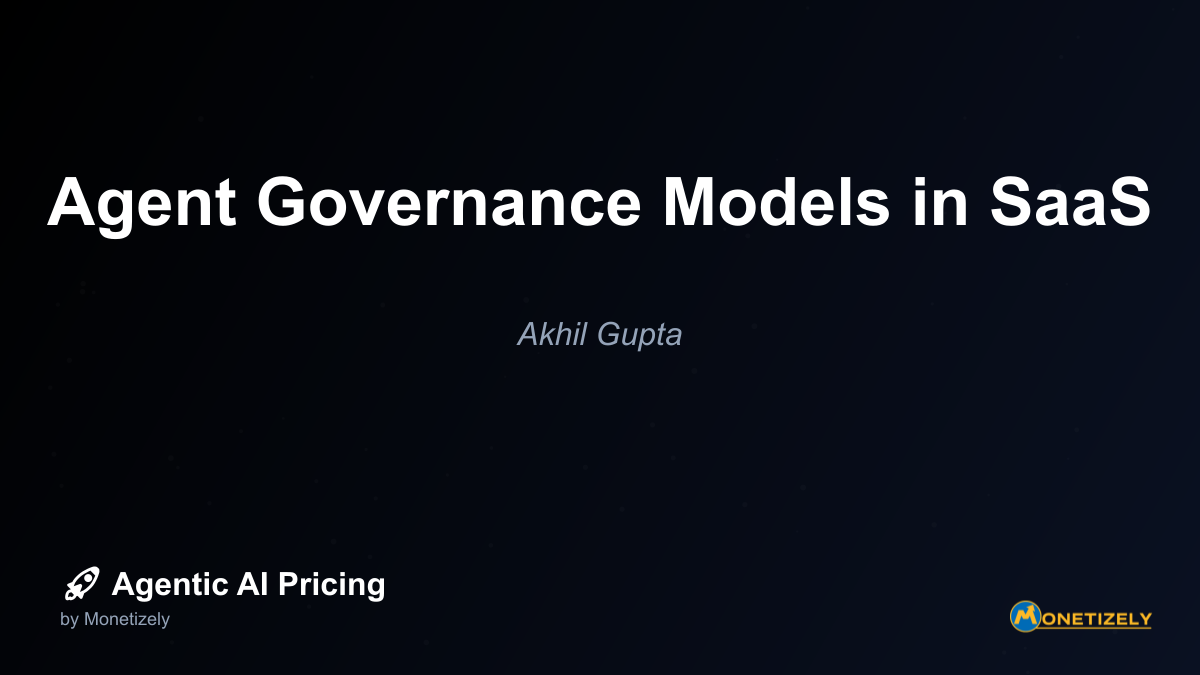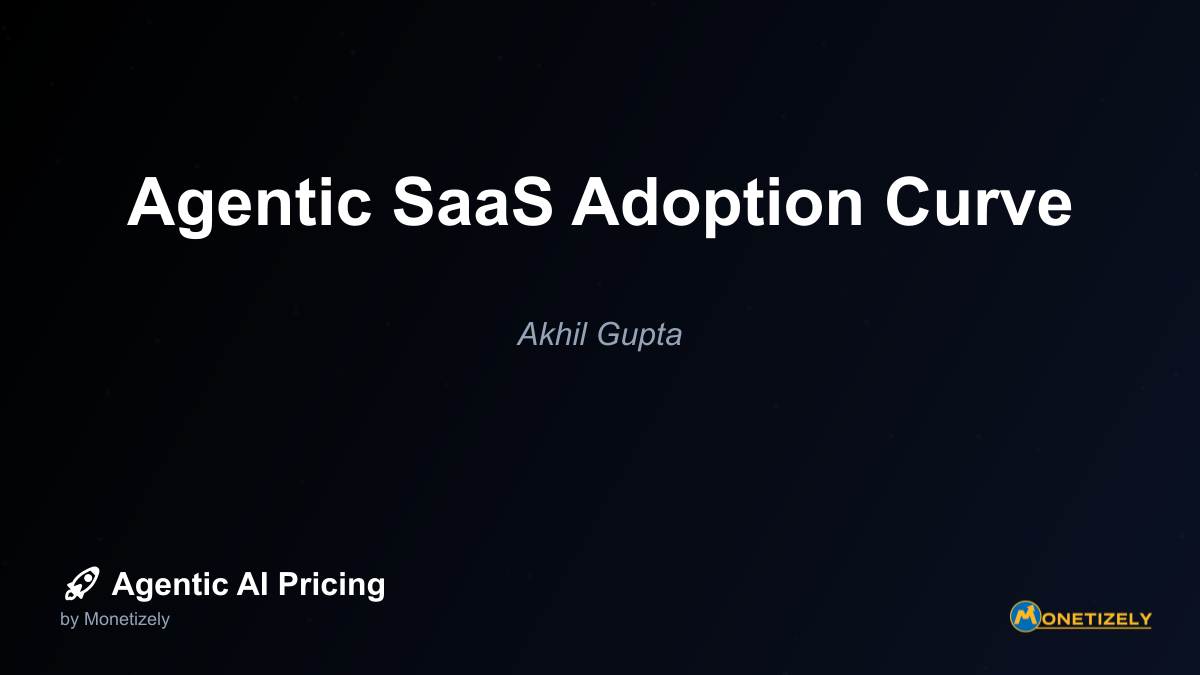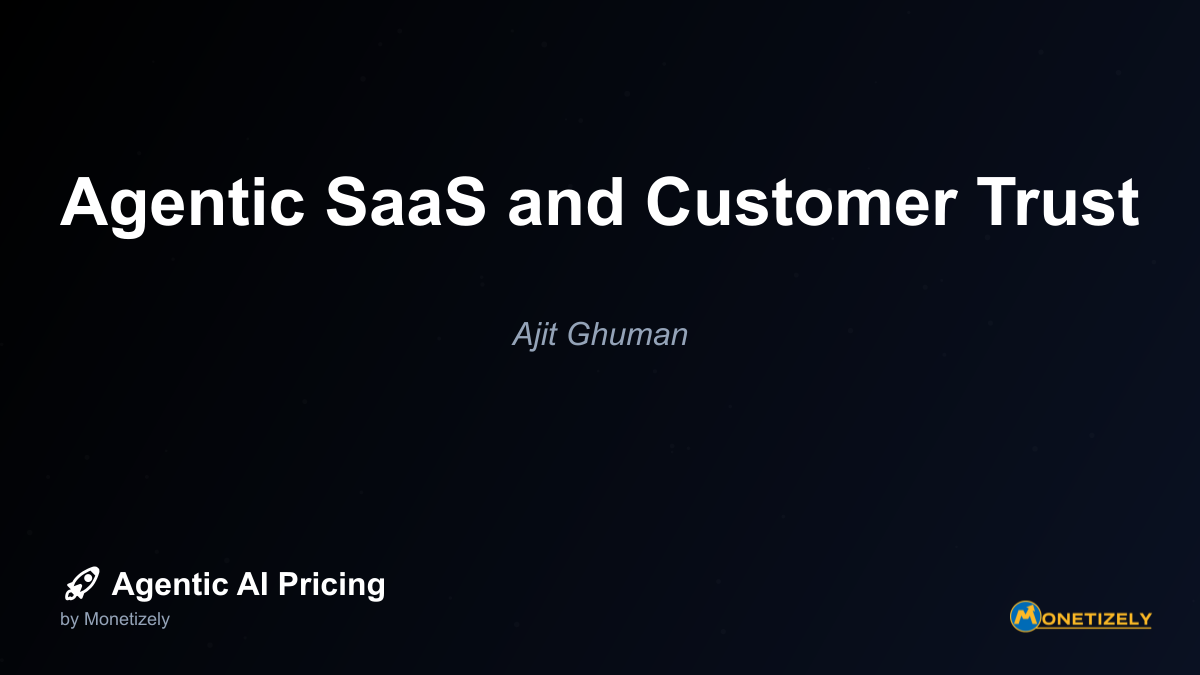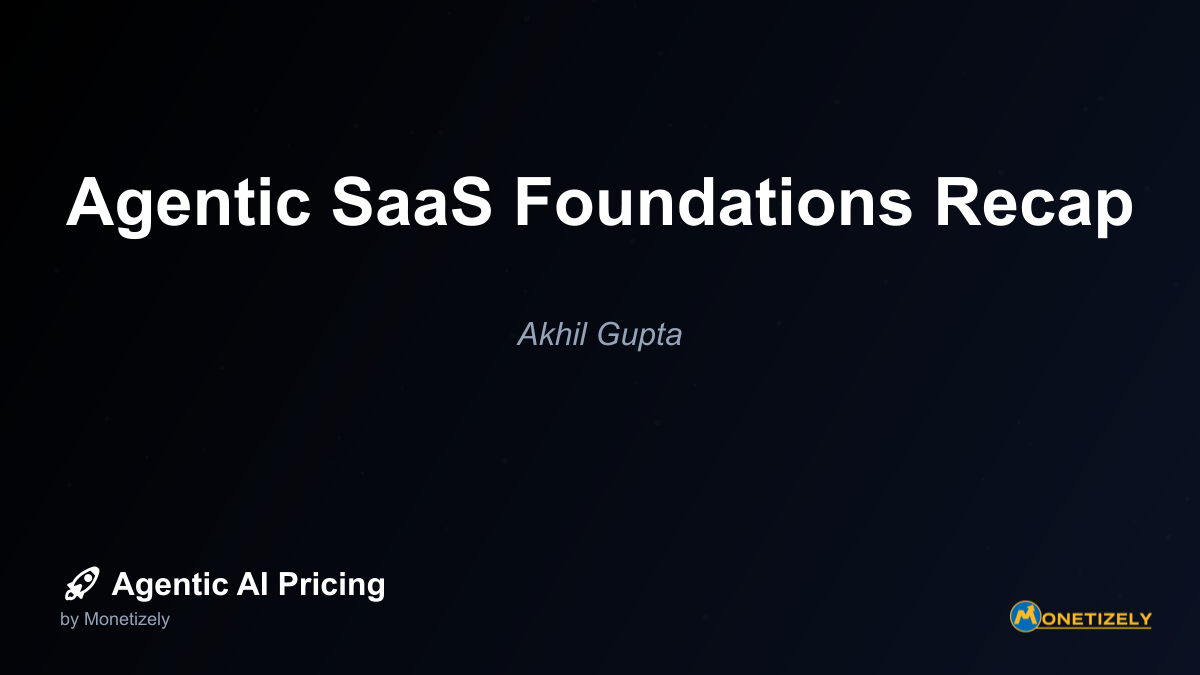· Akhil Gupta · Agentic SaaS Fundamentals · 11 min read
The Role of Multi-Agent Systems in SaaS
AI and SaaS Pricing Masterclass
Learn the art of strategic pricing directly from industry experts. Our comprehensive course provides frameworks and methodologies for optimizing your pricing strategy in the evolving AI landscape. Earn a professional certification that can be imported directly to your LinkedIn profile.
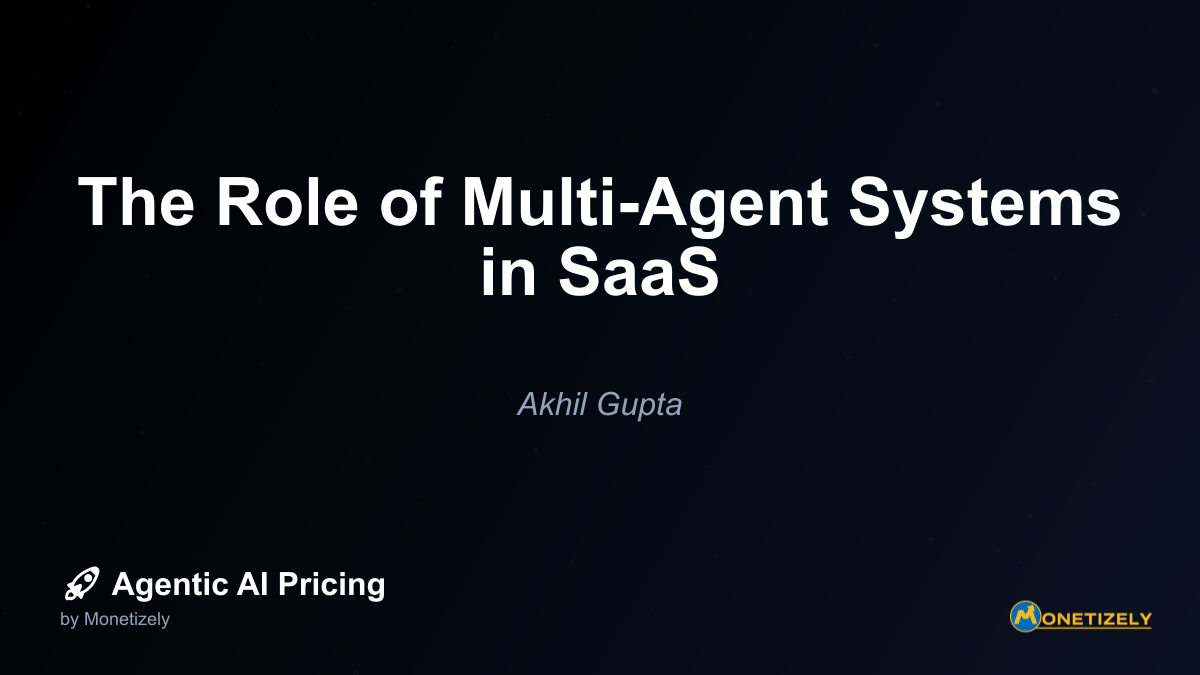
In today’s rapidly evolving technology landscape, multi-agent systems (MAS) are emerging as a transformative force in the Software-as-a-Service (SaaS) industry. Unlike traditional single-agent AI solutions, multi-agent systems leverage the collective intelligence and specialized capabilities of multiple AI agents working in concert to deliver enhanced value, efficiency, and innovation for businesses across sectors.
Understanding Multi-Agent Systems in SaaS
Multi-agent systems in SaaS refer to architectures where multiple AI agents with distinct, specialized roles collaborate to deliver complex services. Rather than relying on a single AI agent to handle all tasks, MAS distributes responsibilities across a team of specialized agents that communicate, coordinate, and adapt in real-time.
The fundamental difference between single-agent and multi-agent approaches lies in their ability to handle complexity and specialization. Single agents attempt to be jacks-of-all-trades, while multi-agent systems employ specialized experts working together—similar to how human organizations function with specialized roles and departments collaborating toward common goals.
Key Components of Multi-Agent Systems
- Specialized Agents: Individual AI agents with specific capabilities and expertise areas
- Communication Protocols: Standards and mechanisms for agents to exchange information
- Orchestration Layer: Systems that coordinate agent activities and manage workflows
- Shared Memory: Repositories where agents can store and access collective knowledge
- Decision-Making Frameworks: Rules and algorithms governing how agents resolve conflicts and make collective decisions
The Market Landscape for Multi-Agent Systems
The global multi-agent system market is experiencing explosive growth, projected to reach approximately USD 6.3 billion in 2025, with an expected compound annual growth rate (CAGR) of 45.5% until 2034, potentially soaring to USD 184.8 billion by 2034. This remarkable expansion is driven by increasing adoption across industries including defense, logistics, manufacturing, and smart infrastructure that rely on distributed AI and autonomous systems.
North America currently dominates this market with a 37.8% share in 2025. Key players in the multi-agent space include established technology giants like IBM, Microsoft, Google DeepMind, AWS, NVIDIA, Oracle, SAP, and OpenAI, alongside innovative startups specializing in agent orchestration and integration.
Industry analyses forecast that by 2026, 75% of large enterprises will adopt multi-agent systems for AI implementations, accelerating the shift from single-agent models to sophisticated multi-agent orchestration platforms.
How Multi-Agent Systems Add Value in SaaS Delivery
The orchestration of multiple AI agents creates substantial value for SaaS platforms in several key dimensions:
Task Specialization and Collaboration
Rather than forcing a single agent to become proficient at everything, multi-agent systems employ specialized agents for specific subtasks. For example, in a content marketing SaaS platform, different agents might handle research, writing, editing, optimization, and publishing. This specialization allows each agent to excel in its domain, producing superior results compared to generalist approaches.
As noted by AI researcher Dr. Melanie Mitchell: “The power of multi-agent systems lies in their ability to decompose complex problems into manageable parts, with specialized agents handling what they do best while collaborating toward shared objectives.”
Intelligent Orchestration
Modern multi-agent systems feature sophisticated orchestration layers that dynamically assign and configure agents based on:
- Task complexity and requirements
- Available computational resources
- Operational priorities and deadlines
- Agent performance metrics and specialties
This intelligent coordination optimizes workflows in real-time, ensuring the right agent handles the right task at the right time, significantly increasing overall system efficiency.
Scalability and Resilience
Multi-agent architectures offer inherent advantages in scalability and fault tolerance:
- Horizontal Scaling: Systems can add more agents to handle increased workloads without redesigning the core architecture
- Load Distribution: Tasks are distributed across multiple agents, preventing bottlenecks
- Fault Isolation: Failures in individual agents don’t necessarily compromise the entire system
- Redundancy: Critical functions can be handled by multiple agents, ensuring continuity
During peak demand periods, SaaS platforms with multi-agent architectures can dynamically scale by activating additional agent instances, then scale down during quieter periods to optimize resource utilization.
Enhanced Complexity Handling
Perhaps the most significant advantage of multi-agent systems is their ability to tackle complex, multi-step workflows that would overwhelm single-agent approaches. By breaking down complex processes into manageable components and allowing specialized agents to handle each step, MAS can support sophisticated use cases like:
- End-to-end business process automation
- Complex decision support systems
- Adaptive customer journey management
- Intricate data analysis and reporting workflows
This capability enables SaaS providers to offer more comprehensive and powerful solutions to enterprise clients with complex requirements.
Architecture Patterns for Multi-Agent SaaS Systems
Multi-agent systems in SaaS environments typically implement one of three primary architectural patterns, each with distinct characteristics and applications:
1. Fully Centralized Architecture
In this approach, a central system controls all agents with centralized training and execution. This pattern ensures high coordination and consistency but requires full data and control access across all agents.
Characteristics:
- Strong central control and visibility
- Consistent agent behavior and policies
- Simplified monitoring and governance
- Potential bottlenecks at the central coordinator
Best for: Enterprise applications with strict governance requirements and complex workflows requiring tight coordination.
2. Decentralized Architecture with Global Credit Allocation
This hybrid approach balances control and autonomy. The system doesn’t directly control agents but incentivizes them through credit allocation for completed tasks, making it suitable for scenarios with partial trust or heterogeneous ownership of agents.
Characteristics:
- Balanced autonomy and alignment
- Incentive-based coordination
- Flexible agent participation
- More complex governance
Best for: Cross-organizational workflows, marketplace-style applications, and systems integrating third-party agents.
3. Fully Decentralized Architecture
This pattern lacks centralized control or credit allocation, forcing agents to self-organize and collaborate autonomously. Mechanism design and coordination protocols become critical for system efficacy.
Characteristics:
- Maximum agent autonomy
- Emergent rather than designed behaviors
- High resilience to central failures
- Challenging governance and predictability
Best for: Highly distributed systems, edge computing applications, and scenarios requiring maximum resilience.
Implementation Approaches and Technical Considerations
Implementing multi-agent systems for SaaS delivery involves several key technical considerations:
Microservices-Based Agent Architecture
Most modern multi-agent SaaS implementations utilize microservices architecture patterns, with agents deployed as individual services orchestrated by a central hub. A typical implementation includes:
- Agent Hub: Central component managing multi-agent execution
- Memory Layer: Shared state and conversation histories (often using Redis with FAISS or Qdrant)
- Task Orchestrators: Systems like Temporal handling dependencies and task chaining
- LLM Integration: Connections to models like Anthropic Claude 3 or open-source alternatives
- API Gateway: Exposing endpoints via FastAPI, NGINX, or similar technologies
- Monitoring and Analytics: Observability through Prometheus and custom dashboards
Event-Driven and Serverless Approaches
Many SaaS implementations leverage event-driven architectures with message brokers (Kafka, RabbitMQ) and serverless compute functions (AWS Lambda) to invoke agents dynamically in response to events. This approach offers several advantages:
- Minimized UI blocking during agent operations
- Improved scalability through event-based triggering
- Stateless frontends with state maintained in orchestrators
- Asynchronous agent execution for better resource utilization
Agent Communication and Coordination
Effective agent communication is critical for multi-agent systems. Common approaches include:
- Shared Chat History: Frameworks like Microsoft’s Autogen use conversational agents interacting in group chats managed by a
GroupChatManager - Message Passing: Structured data exchange through predefined protocols
- Blackboard Systems: Shared knowledge repositories where agents post and retrieve information
- Agent2Agent Protocol (A2A): Emerging standard enabling agents built on different frameworks to communicate securely
Integration Challenges and Solutions
Integrating multi-agent systems with existing SaaS infrastructure presents several challenges:
Communication Overhead: Coordinating many agents can cause high latency and resource drain
- Solution: Advanced communication protocols and efficient message passing
Conflict Resolution: Agents with overlapping or conflicting goals need mechanisms to resolve inconsistencies
- Solution: Sophisticated algorithms and priority frameworks
Scalability: Managing thousands or millions of agents requires special architectural considerations
- Solution: Distributed architectures and dynamic scaling mechanisms
Security and Privacy: Multi-agent systems must defend against malicious agents and comply with regulations
- Solution: Rigorous security controls and data governance frameworks
Interoperability: Diverse agents often run on different protocols or legacy systems
- Solution: Adopting shared standards like MCP (Multiagent Communication Protocol) and A2A
Real-World Applications of Multi-Agent Systems in SaaS
Multi-agent systems are transforming SaaS delivery across numerous industries. Here are some notable applications:
Customer Experience and Support
Enterprise SaaS platforms leverage multi-agent systems to orchestrate comprehensive customer journeys by employing specialized agents for:
- Onboarding and education
- Issue triage and categorization
- Problem resolution and troubleshooting
- Personalized engagement and follow-up
These agents maintain conversation context across channels (web, mobile, phone), enabling omnichannel consistency and human-in-the-loop escalation when needed. Monitoring and predictive agents support proactive service to reduce ticket volumes and improve satisfaction.
Supply Chain Management
Multi-agent SaaS solutions for supply chain management enable distributed agents representing suppliers, manufacturers, distributors, and retailers to collaborate and share real-time inventory data. These systems optimize:
- Demand forecasting
- Production planning
- Routing and scheduling
- Inventory management
The result is decreased stockouts, reduced delivery times, lower fuel consumption, and enhanced operational efficiency across the entire supply network.
Manufacturing Systems
In manufacturing environments, multi-agent SaaS platforms manage tasks like:
- Production scheduling
- Inventory checking
- Equipment maintenance
- Quality control
Agents communicate autonomously to optimize resource usage and minimize downtime. This decentralized control allows real-time monitoring and workload redirection across assembly lines to improve throughput and production quality.
E-commerce and Retail
Multi-agent systems power advanced e-commerce SaaS platforms through:
- Personalized product recommendations
- Dynamic pricing optimization
- Inventory management
- Fraud detection and prevention
Agents analyze user data (browsing history, preferences, purchase behavior) collaboratively, enabling scalable high-volume transaction processing and enhanced customer engagement.
Content Marketing and Creation
Content marketing platforms increasingly leverage multi-agent systems with specialized agents for:
- Research and topic identification
- Content planning and outlining
- Writing and content generation
- Editing and quality control
- SEO optimization
- Distribution and analytics
This division of labor produces more comprehensive and higher-quality content than single-agent approaches.
Case Studies: Multi-Agent Systems in Action
GitHub Copilot Workspace
GitHub’s Copilot Workspace exemplifies multi-agent collaboration for software development workflows. The system splits tasks among specialized agents for:
- Planning and architecture
- Documentation retrieval
- Code generation
- Testing and validation
By orchestrating these specialized agents, Copilot Workspace delivers more comprehensive and contextually appropriate assistance to developers than a single-agent approach could achieve.
HubSpot’s Customer Service Automation
HubSpot employs a multi-agent approach to customer service automation, with agents specialized for:
- Routing support tickets to appropriate departments
- Suggesting automated replies based on ticket content
- Flagging anomalies in customer relationship data
- Generating follow-up content and recommendations
This multi-agent approach has improved response times and customer satisfaction while reducing support staff workload.
Notion AI’s Content Assistance
Notion AI uses embedded multi-agent systems for content creation and management, with specialized agents handling:
- Content summarization
- Document rewriting and formatting
- Data structuring and organization
- Information retrieval and synthesis
These collaborative agents enhance user productivity by handling different aspects of content management within the Notion ecosystem.
Pricing Models for Multi-Agent SaaS Solutions
Pricing multi-agent systems in SaaS environments presents unique challenges and opportunities. Several models have emerged as particularly effective:
Agent-Based Pricing
This model charges based on the number and types of agents deployed. Customers can select which specialized agents they need, creating customized agent teams tailored to their specific requirements.
Example:
- Basic package: 3 core agents ($X/month)
- Professional package: 7 specialized agents ($Y/month)
- Enterprise package: Unlimited agents with custom capabilities ($Z/month)
Consumption-Based Pricing
This approach charges based on actual usage metrics such as:
- Number of agent invocations
- Processing time consumed
- Data volume processed
- API calls made
Consumption-based models align costs directly with value received and allow for flexible scaling.
Outcome-Based Pricing
Some advanced multi-agent SaaS providers are experimenting with outcome-based pricing, where fees are tied to measurable business results such as:
- Revenue generated
- Cost savings achieved
- Efficiency improvements
- Quality metrics
This model aligns provider and customer incentives but requires sophisticated tracking and attribution mechanisms.
Hybrid Models
Many successful multi-agent SaaS offerings use hybrid pricing combining:
- Base subscription for core functionality
- Per-agent fees for specialized capabilities
- Usage-based components for variable consumption
- Outcome-based incentives for shared success
As our comprehensive guide to AI solution pricing explains, these hybrid approaches provide the flexibility needed to capture value appropriately while remaining competitive.
Enterprise vs. SMB Approaches to Multi-Agent Systems
The implementation and adoption of multi-agent systems differ significantly between enterprise and SMB customers:
| Aspect | Enterprise Approach | SMB Approach |
|---|---|---|
| Scale | Deploy large, complex MAS networks with thousands of agents | Begin with small, focused agents for critical tasks |
| Customization | Highly customized agents tailored to specific workflows and compliance | Use off-the-shelf agent solutions with limited customization |
| Integration | Deep integration with extensive legacy systems and data governance | Minimal integration, relying on cloud-native, API-first SaaS platforms |
| Security & Compliance | High emphasis on regulatory compliance and cybersecurity | Basic security but less regulatory burden |
| Investment | Significant upfront investment with dedicated teams | Cost-sensitive; prefer SaaS pay-as-you-go and rapid deployment |
| Governance | Strong governance frameworks and multi-agent orchestration layers | Lighter governance; focus on ease of use |
Enterprises typically prioritize interoperability standards, scalability, and comprehensive agent orchestration, while SMBs focus on immediate ROI and ease of deployment by starting with smaller agent sets.
Measuring Success: Performance Metrics for Multi-Agent Systems
To evaluate the effectiveness of multi-agent systems in SaaS delivery, organizations track several key performance indicators:
Task Completion Rate
The percentage of tasks that agents successfully complete without human intervention. This metric directly measures system autonomy and effectiveness.
Efficiency Metrics
- Processing time per task
- Resource utilization (compute, memory, bandwidth)
- Communication overhead between agents
- Cost per completed task
These metrics help optimize resource allocation and identify bottlenecks in agent workflows.
Scalability Metrics
- Performance retention or gains with increased agent count
- Response time under varying load conditions
- Resource scaling linearity
- Peak capacity handling
Scalability metrics ensure the system can grow to meet increased demands without degradation.
Robustness Metrics
- System resilience against agent failures
- Recovery time after disruptions
- Performance under adverse conditions
- Anomaly detection and handling
Robustness metrics measure the system’s ability to maintain operations despite challenges or failures.
Business Impact Metrics
- Time savings compared to manual processes
- Cost reduction achieved
- Quality improvements
- Customer satisfaction scores
- Revenue generation or preservation
These metrics connect technical performance to tangible business outcomes.
Regulatory and Ethical Considerations
As multi-agent systems become more prevalent in SaaS delivery, several regulatory and ethical considerations emerge:
Transparency and Explainability
Multi-agent systems must provide transparency in their decision-making processes, especially when agents autonomously act on behalf of users or influence critical decisions. This includes:
- Clear documentation of agent roles and capabilities
- Audit trails of agent actions and decisions
- Explainable AI techniques to clarify agent reasoning
Data Privacy and Compliance
When agents access or share sensitive user data during interaction, compliance with regulations like GDPR or CCPA becomes critical. Approaches include:
- Federated or decentralized architectures limiting centralized data harvesting
- Fine-grained access controls for agent data usage
- Comprehensive data governance frameworks
- Privacy-preserving computation techniques
Accountability Frameworks
Organizations must establish clear accountability for agent actions, including:
- Mechanisms to detect agent bias or failure modes
- Rigorous testing and monitoring protocols
- Documentation of agent behaviors and limitations
- Clear liability assignments for automated decisions
Ethical Agent Design
Ethical considerations in multi-agent system design include:
- Preventing harmful emergent behaviors in agent collectives
- Ensuring fair treatment across user demographics
- Avoiding manipulative or deceptive agent interactions
- Maintaining appropriate human oversight and intervention capabilities
Future Trends in Multi-Agent SaaS Systems (
Co-Founder & COO
Akhil is an Engineering leader with over 16+ years of experience in building, managing and scaling web-scale, high throughput enterprise applications and teams. He has worked with and led technology teams at FabAlley, BuildSupply and Healthians. He is a graduate from Delhi College of Engineering and UC Berkeley certified CTO.
Pricing Strategy Audit
Let our experts analyze your current pricing strategy and identify opportunities for improvement. Our data-driven assessment will help you unlock untapped revenue potential and optimize your AI pricing approach.

